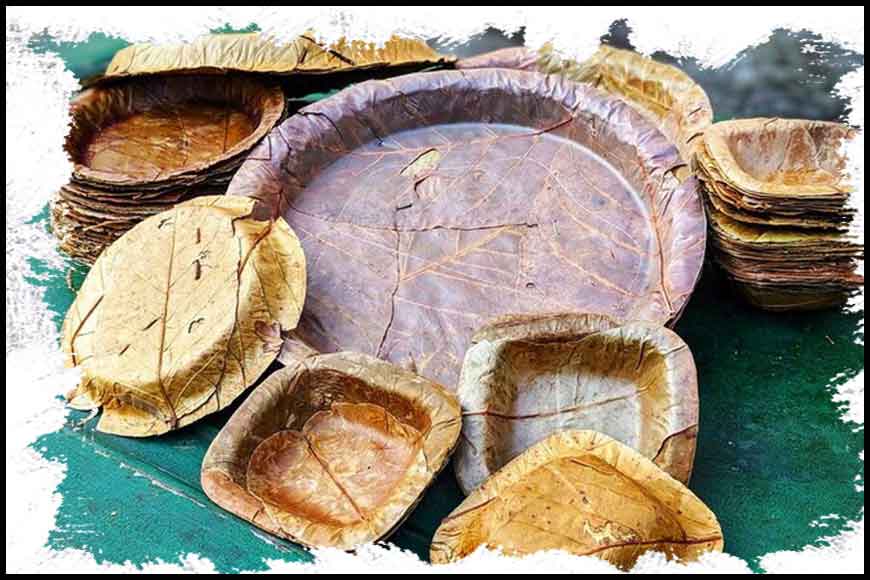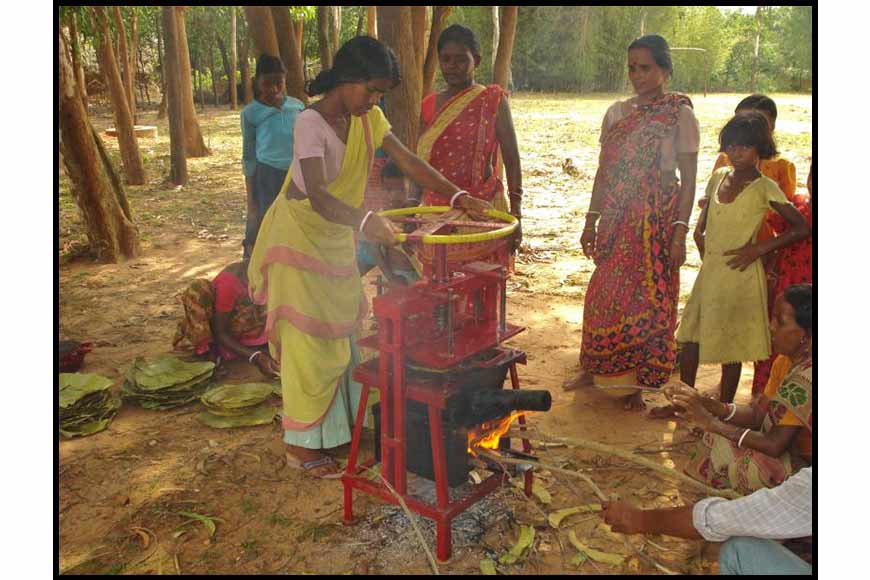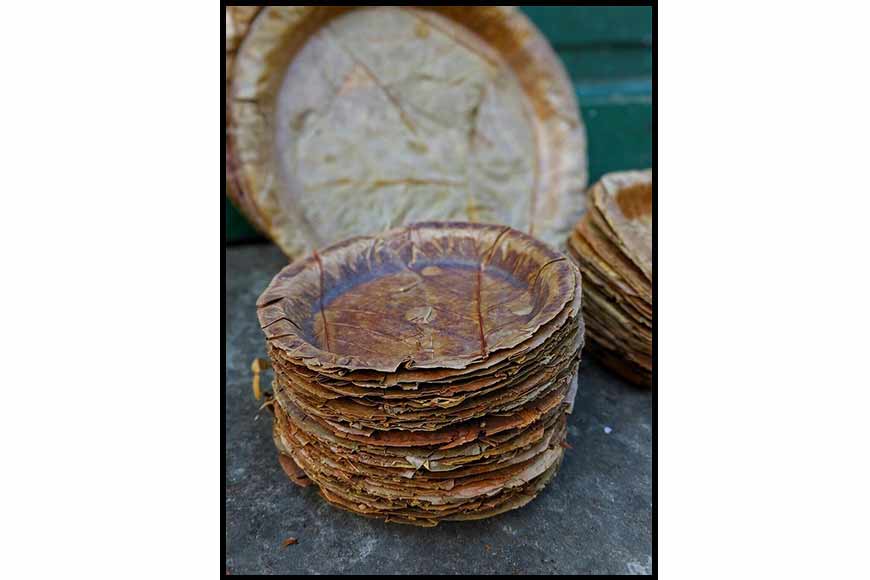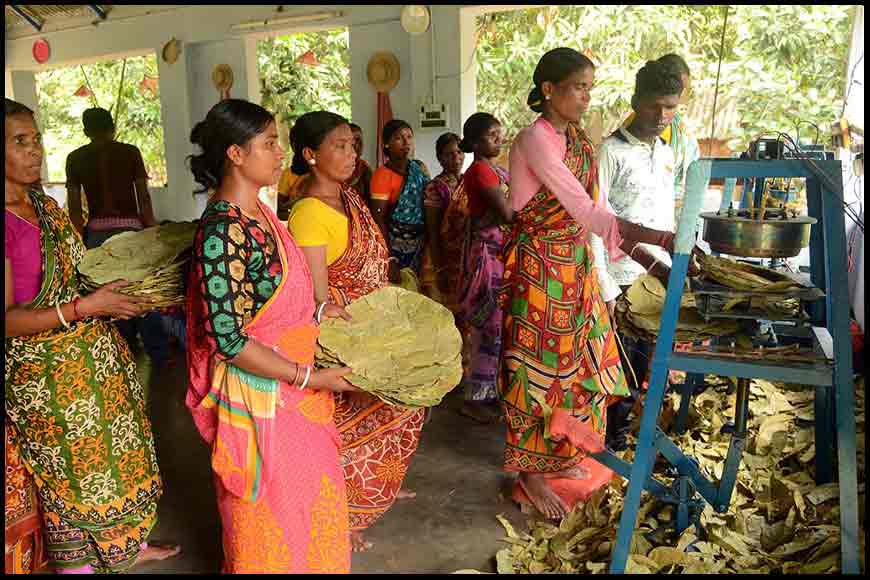Sal leaf utensils - a Bengal speciality!

Since ancient times, our bonding with nature has been very close. We worship Gods with offerings of ‘shadopachara’ (16 items) and that includes ‘Naivedya’ (edible offerings) of cereals, vegetables and fruits on leaves or utensils made of leaves. After offering the naivedya to the deity, it becomes prasad that is distributed among the devotees. According to Acharya Charak, father of Ayurvedic medicines and author of ‘Charak Samhita’, the practice of eating food on leaf plate with hands is an act of ‘sparsh’ (touch) that connects all the sense organs with the mind.
Plant and tree leaves belonging to a variety of families of the plant kingdom are used as single leaf plates, stitched dining leaf plates, food wraps, and food packing material. Of these, the leaves of banana plant and Sal leaves are in vogue in Bengal.
In the past, during community feasts and religious festivals, it was customary to serve meals on plantain leaves or utensils made of leaves. The tradition of serving meal on leaves and leaf plates was considered as pure and good practice during special occasions such as weddings, births, thread and shraddh ceremony. Again, it is customary for most Indians to congregate and partake in community feasts in temples and during festivals like Durga Puja. During these occasions, people from all walks of life sit and feast on ‘Pujor Bhog’ together. This is symbolical of universal brotherhood as people sit in rows, irrespective of their status during such traditional feasts. In the past, during these feasts, food used to be served on leaves or leaf plates.

Plastic bags were invented by Swedish engineer Sten Gustaf Thulin who created them in 1959. The bags were developed as an alternative to paper bags, which were considered bad for the environment because they resulted in forests being chopped down. In fact, before plastic took over our lives, leaves were used extensively for packing meals and groceries, raw meat and chicken etc and the practice is prevalent in villages even to this day.
In the past, during community feasts and religious festivals, it was customary to serve meals on plantain leaves or utensils made of leaves.
Plant and tree leaves belonging to a variety of families of the plant kingdom are used as single leaf plates, stitched dining leaf plates, food wraps, and food packing material. Of these, the leaves of banana plant and Sal leaves are in vogue in Bengal. Shorea robusta aka sal is a large, deciduous, highly regenerating, high timber valued tree belongs to the family Dipterocarpaceae. ‘Sal’ in Sanskrit means ‘house and is also known as saluva, dammar, and ral in other Indian languages. It holds immense religious significance for Hindus, Jains and Buddhists. It is a native tree of the Indian subcontinent and is widely found in India, Myanmar, Nepal, Bangladesh, and Bhutan. In India, the tree is widely found in the jungles of Odisha, West Bengal, Bihar, Jharkhand, Madhya Pradesh, Chhattisgarh, Haryana, Assam, Tripura, Andhra Pradesh, and Himachal Pradesh. The leaves are of 10–25 × 5–15 cm size and used in Ayurveda and Unani for treating ulcers, wounds, leprosy, earache, and headache. The leaves are rich source of various flavonoids and exhibit anti-inflammatory, anti-bacterial, anti-pyretic, analgesic and wound healing properties.

Fresh Sal leaves are used for serving snacks and the sun-dried leaves are stitched together using grass stem sticks or sewing machine to produce leaf plates (thala) and leaf bowls (donga). The leaf plates are used for serving meals during domestic and ceremonial occasions. In the temple of Lord Jagannath at Puri, the mahaprasad is served to the devotees in sal leaf plates. The used plates serve as fodder for the goats and cattle roaming on the streets.
Sal leaves grow in abundance in the forest fringe areas of Purulia, Bankura and Jhargram districts of West Bengal. Collecting sal leaves from the forests round the year is one of the revenue-generating activities for the landless, marginal and forest-dependent tribal people living in these districts. Leaf plate making has traditionally been a source of income for the rural people of Birbhum, Burdwan and West Midnapur districts as well. Groups of women collect sal leaves from the jungles and then they attach the leaves and hand-stitch them to make utensils. Nowadays, the leaves are stitched mechanically. In the villages of North Bengal neighbouring the forests, locals have been engaged in making sal leaf utensils for generations. The utensils are made at Salugara Range under Baikunthapur forest area in Jalpaiguri district.
Plant and tree leaves belonging to a variety of families of the plant kingdom are used as single leaf plates, stitched dining leaf plates, food wraps, and food packing material. Of these, the leaves of banana plant and Sal leaves are in vogue in Bengal.

A large number of forest conservation committees are active in the Terai and Dooars region of North Bengal. The state forest department has further formed sub-committees to keep a strict vigil on forests and save the trees from illegal felling. These committees also train rural women of the locality to help them attain economic independence. Mr Manoj Kumar Chowdhury, a member of the Baikunthapur forest conservation committee says, villagers of Gajoldoba, Mantadari, Ashighar, Naresh More and Rasfapri are assigned to collect sal leaves from the forest and deposit every week. Each village collects around 20 to 40 thousand sal leaves on an average. The large leaves used for making large plates are bought at the rate of Rs 35 – Rs 40 for one hundred leaves and smaller leaves required for making medium to small plates are bought for Rs 30 to Rs 35 for one hundred leaves.
The leaves are then transported to the factory at Salugara Range under Baikunthapur forest area. Three machines have been installed to make utensils from the sal leaves. Around 12,000 large and medium sized plates are manufactured here daily. These utensils have great demand not onl;y within the country but are also exported. They are sold in the market at the rate of Rs 70 for one hundred large plates and Rs 60 for medium sized plates.










